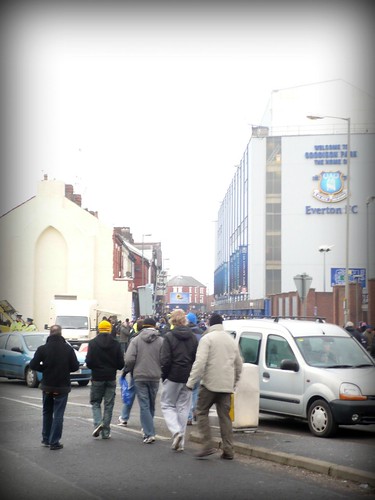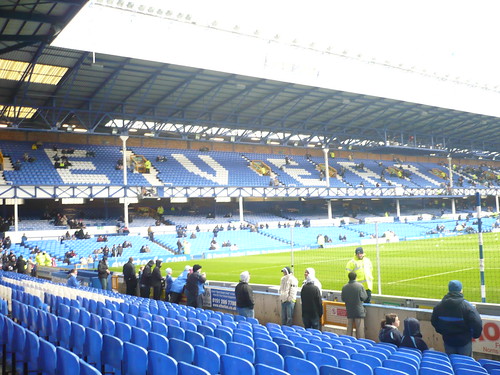
Alas, 'twas not to be. So after a short Sandbach sojourn to assess my options - very few - I chose to screech left at Thelwall and set a course for Goodison Park.
This, as it happens, was the first football ground I ever visited - back on 5 May 1990 with my Swedish pal Jaws - and I last visited in 1994, a rare punctuation mark in my mostly televisual relationship with the Blues.
Family never bequeathed me a football team. Instead my parents sent me to a different school at which all 'the glories' (except Jaws) supported Liverpool. I dutifully chose Southall, Nevin, and Stuart McCall. Everton remains my second eleven - but I grew up, started to go to football, and - critically - never got Sky.
One fact remains: I still need some motivation to watch Match of the Day infrequently.
That summer day, I can still recall, we followed a group of Aston Villa fans with an airhorn past freshly-planted beds in Stanley Park. The roaring nineties were barely underway, and teams could get away with fielding moustachioed centre halves like Derek Mountfield.
We blinked in the glare as we ascended to our seats from the dank intestines of the Bullens Road stand, with its vast and gloomy shadows. I remember the visceral impact of seeing more people than I'd ever seen in one place before, and that huge Main Stand opposite. I can still hear and feel the thudding of feet on the balcony at moments of excitement.
The place felt epic, as things do when you're a child. That was my first experience of a football stadium, and it still shapes my expectation. While I've downsized since then (a lot), I still like a football ground to have a relationship and a sense of interaction with its surroundings.
Goodison epitomises this, and feels both lived in and lived around. This part of Liverpool is among the purest of tarditional football landscapes in England. Grandstands from the 1930s, 1970s and 1990s (boooo - the old Park End looked great) tower above tightly-packed terraces and narrow streets, a picture offset by a majestic Victorian park (currently under restoration, looks good) and the occasional glimpse of a distant dockyard crane.

Today, Hull City were the visitors. I haven't been to a top-flight game since Highfield Road (RIP) some thirteen years ago.
I felt a guilty sense of anticipation, and, on approaching the ticket office, not a little paranoia. Like a tourist I clutched my wallet anxiously, especially since a real-lifeLiverpudlian had in real life offered to look after my car in exchange for a real-life tenner.
Ten notes, they tell me, is normal. Fourth division it ain't. Which is genuinely grim.
Very nearly deterred I demanded the cheapest ticket in the house. A large sum of money secured me a berth in what felt like steerage, an enclosed position way back beneath the upper tier of the Gwladys Street end, a steel-and-plank structure dating back to 1938.
It was close enough to the ceiling that I could inspect the botchy repointing of the balcony floor, and well behind two enormous steel girders with mighty rivets, big ones like they don't make anymore.
If you like traditional football grounds, Goodison is a thrilling survivor. There's only one Premiership-era stand at the Park End. The rest is true vintage. Even the titanic Main Stand, erected in the seventies, could never have been built to a standard pattern - it's wedge-shaped design created to accommodate the surrounding streets. In aerial photos, it doesn't look all that different to its predecessor - it's still a snug fit with its community.
Despite being built years apart, Gwladys Street (1938) and Bullens Road (1926) retain the unity of a pre-war Leitch design, although their upturned roofs are later additions. There's also an antique combination of wooden panelling and cross-hatched balcony trusses that inspires a real sense of timelessness if you've ever seen it in footage of Pele, Eusebio or North Korea in the 1966 World Cup finals.
To our right, the old church, St. Lukes. Offering refreshments before the match, it still occupies a corner of the ground, despite long-forgotten attempts to demolish it in the thirties.
So, what is Premiership football like in 2008?
Eek. It's different. It has those animated advertising hoardings that made Serie A look exotic in the last century. Gone are the ticket stubs (I rifled through my coat, convinced I'd lost mine) replaced by a swipey barcode system awkwardly appended to the old turnstiles (this had to be explained to me, step-by-step). Fancy.
Newly arrived are far-eastern tourists doing John Lennon peace signs next to a superhuman-looking bronze of Dixie Dean. Oh, and you're supposed to turn on your Bluetooth so that a low-resolution version of Mikel Arteta can invade your handset with various offers. Anthropologically, it's interesting, as academics like to say indifferently.
But - I also noticed how well-kept the ground is. Not in a flower beds kind-of-way, but just in the sense that it seems painted and looked after, rather than peeling and rusty. The scrawled "NF" and "Keep Everton White" graffiti seems to have been consigned to a bygone era, which can't be a bad thing either, with all of today's bile reserved for Nick Barmby, who moved across the park to Anfield back in 2000.

And - there's a strangely intensifying effect to be had when watching from a darkened vantage point that's way back beneath. The game - a 2-0 win for a striker-less Everton against a team that barely made its presence felt - wasn't that inspiring. But Goodison Park is like being in a rowdy zombie movie. The noise is amplified, hoardes rise and groan as one, and you can't see the sky - only the crowd and the pitch.
Since I normally spend long periods looking at other fans or at the surrounding landscape beyond low-rise terraces, it's a novel - or at least, half-forgotten - experience. It's a long time since I've been stuck in traffic after a game or swept along with the crowd through a narrow street, but it's one worth repeating once in a while.
Oh, yes - and this was very exciting indeed. For just a moment, I recalled vaguely the allure of following a team that can play a bit. But only a bit ;-)

No comments:
Post a Comment